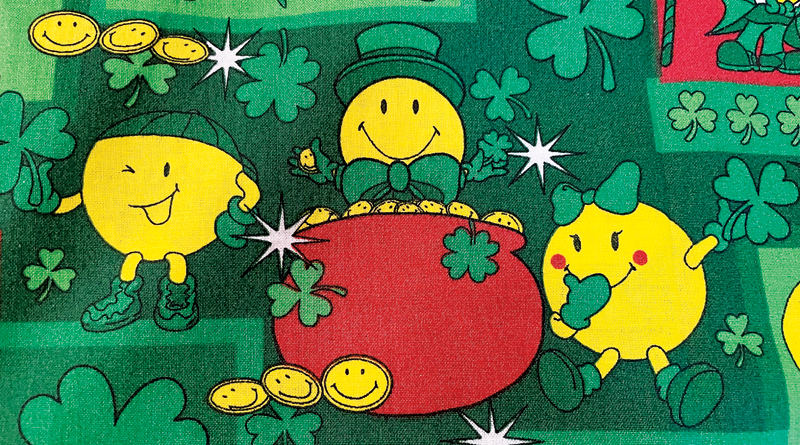When Irish Smiley Faces Are Smiling! – Around The Frame
Not long ago I came across a piece of fabric that made me, well, SMILE! It features cute boy and girl smiley faces decked out in Smiley Face attire for St Patrick’s Day.

Now I’m certain, being that “time of year”, that the media will relate the origins of St. Patrick’s Day: St Patrick driving the snakes our or Ireland yada yada… but here, in the Waynedale News, you are being treated to the origins of: Smiley Face St. Patrick’s fabric.
Going online to research the origins of the Smiley Face, I found an article written by Emma Taggart, a contributing writer for My Modern Met. Emma’s article was so well researched, I contacted My Modern Met via their website mymodernmet.com and received permission to share Ms. Taggart’s article with you:
Who Invented the Smiley Face? Discover the Not-so-Smiley History of the Graphic Yellow Icon
The iconic yellow smiley face—with its perfect circle, two oval eyes and a large, upturned semi-circular mouth—is immediately recognizable worldwide as the symbol for happiness. However, the story behind the graphic motif isn’t as cheerful as you might expect.
Who Invented the Smiley Face?
The classic smiley dates back to 1963 in Worcester, Massachusetts, when graphic designer Harvey Ball was commissioned by State Mutual Life Assurance Company to create an image to boost staff morale. Apparently, Ball spent just 10 minutes drawing up a deconstructed smiling face on yellow paper—a surface he chose simply “because it was sunshiny and bright.” Ball was paid a whopping $45 for his now world-renowned visual.
At first, the insurance company printed Ball’s design on buttons and posters to give out to its employees, hoping to cheer them up. It’s unknown whether the “happy” memorabilia did the trick; however, the image quickly gained popularity. Yellow smiley faces started popping up on everything, from greeting cards and stickers to T-shirts and key rings. And although it is widely accepted that Ball invented the smiley, neither he nor the insurance company trademarked the now-iconic design.
The Smiley’s Copyright Controversies
Over time, there were many legal battles over who could truly claim ownership over the smiley face design. During the early 1970s, Hallmark owners Bernard and Murray Spain copyrighted the design with the slogan “Have a Happy Day.” The brothers sold more than 50 million smiley buttons and countless other products featuring Ball’s original graphic. Their aim was to turn a profit while attempting to gain back America’s optimism during the Vietnam War. The brothers publicly took credit for the feel-good symbol in 1971 when they appeared on the television show What’s My Line (despite knowing that Ball was the original designer).
In 1971, French journalist Franklin Loufrani launched The Smiley Company, which grew into a global licensing giant that still exists today. Even Walmart tried to copyright the Smiley in 2006, but lost the case to The Smiley Company, which now holds the rights to smiley face symbols in over 100 countries.
In 2001, Charlie Ball (Harvey Ball’s son) attempted to rescue his father’s creation from the world of consumerism by starting the World Smile Foundation, a company that focuses on small, grassroots charitable efforts. “Harvey Ball believed that each one of us has the ability to make a positive difference in this world and he lived according to that belief,” says the World Smile Foundation on its website. “He knew that any effort to improve the world, no matter how small, was worthwhile. And he understood the power of a smile and a kind act.”
The Evolution of the Smiley Face
There’s been countless variations of the iconic smiley face over the years. Along with its design, its meaning has also changed according to social and cultural values of the time. What began as a simple symbol of optimism in the ‘60s became a commercialized logo in the ‘70s, and an emblem of rave culture in the ‘90s. Today, the smiley appears on fashion items, and even as its own visual online language in our text messages and social media posts. It’s interesting to wonder; would we still have the same emojis we know today if it wasn’t for Harvey Ball’s 10-minute doodle?
So now you know the origins of my Smiley St. Patrick’s fabric’s design. The selvage reads, “Smiley for Kids F. Loufrani” followed by the trademark and copyright symbols, manufacturer, and distribution information.
Now if my 2.5 yards of Smiley fabric makes you feel happy, don’t get all gloomy because a nice couple who live in Oceanside, California have already purchased it and I imagine she’s busy crafting with it. I imagine she had the Luck of the Irish!
Thanks again to Emma Taggart and My Modern Met. I found many other fascinating art-related articles on their website. You may find some too!
REMINDER: Saturday, March 19 is International Quilting Day! Take time to visit your locally woman-owned quilts shops. I know of one who will be having a sale that day!
- The Stars & Stripes Are Forever: Around The Frame - July 5, 2024
- Sam Butcher: A Life Filled With Precious Moments ~ Around The Frame - June 7, 2024
- Aunt Dora & Her Well-Lived Life ~ Around The Frame - May 10, 2024


